Muang Boran, the ancient city, is one fascinating sight that is missing from every traveller’s guidebook and website. After a day trip to this amazing park/outdoor museum, it feels as though we have toured the whole country. Honestly – and I’m not exaggerating here – Muang Boran is hands-down the best place I’ve ever visited in Thailand.
First of all, the place is so huge, it is a city in its own right! You can explore more than 100 historic landmarks all in one place! Not only is the park in the shape of Thailand, the landmarks are placed according to their actual location. This meticulously-designed museum is literally a miniature Thailand!
The ancient city is located in Samut Prakan province outside Bangkok. We hired a cab to take us there and back to our hotel. It was an hour’s drive to get there. And – I can’t stress this enough – it was so totally worthwhile!
The sheer size of the park makes it practically impossible to explore on foot. But you can drive your car in (for a fee), rent bicycles and even buggies! Boy do we love the buggies. It sure brings back memories of Bintan Lagoon Resort!
With that, we’re ready to begin our journey back to the past!
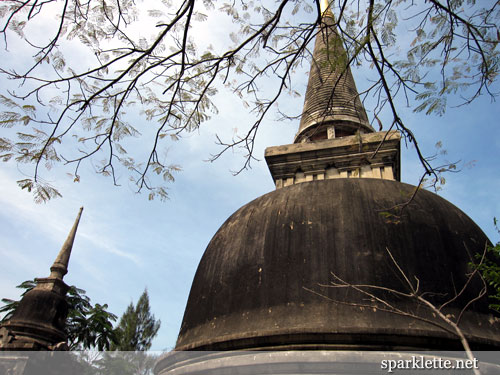
Most of the landmarks here are replicas that have been painstakingly constructed to accurately match the originals. The bell-shaped stupa is a third smaller than the actual monument at Nakhon Si Thammarat. Do they deliberately give it a faded paint job? Because it sure looks every bit as aged as the original that was built in 555 A.D.! In fact, it looks just like the stupas from the ruins of Ayutthaya!
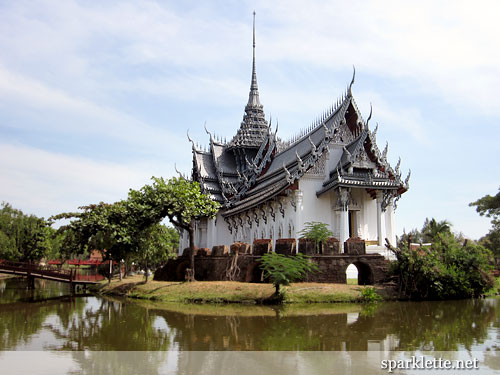
The masterpiece of ancient city is the beautiful Sanphet Prasat Palace from the early Ayutthaya period. What’s incredible is that the palace was completely destroyed in 1767 when Ayutthaya fell to Burma. But through extensive study of archaeological and historical evidence, plus sheer determination, the palace has been rebuilt in Muang Boran.
Isn’t it remarkable how Muang Boran has made it possible for us to walk amongst the buildings from centuries ago, even the ones that have been completely destroyed? Centuries from now, would anyone build a miniature Singapore?
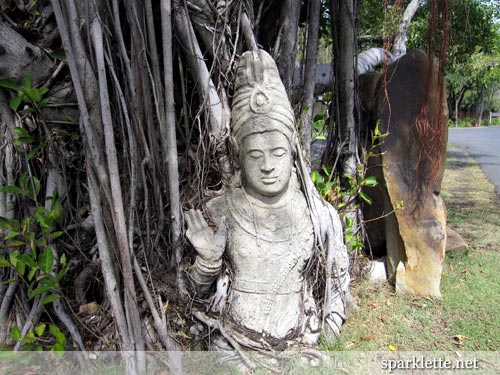
One particularly famous Buddha head at Wat Mahathat in Ayutthaya has tree roots growing around it but, strangely, never quite covering the face. Similarly, this image of a Hindu deity also has tree roots growing around it. (Gotta say that the Buddha head is more intriguing though.) Doesn’t he look like he’s waving?
The original statues are kept at the Nakhon Si Thammarat National Museum.
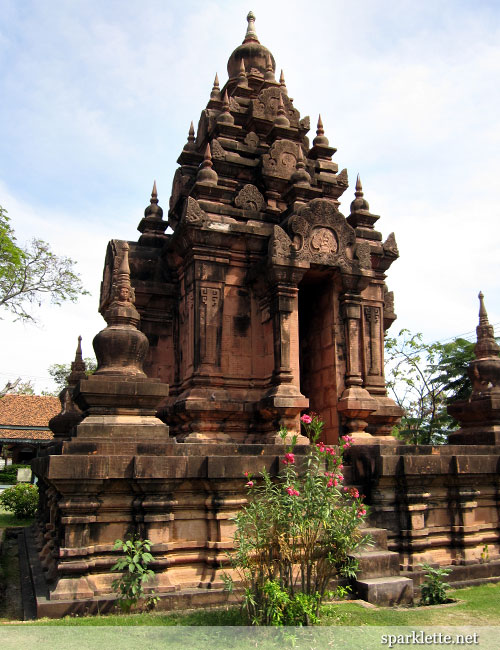
The Phra Mahathat of Chaiya is one of the most sacred and important monasteries in the South of Thailand. The design of the mud-red stupa was inspired by the most ancient form of stupa found in Java, Indonesia.
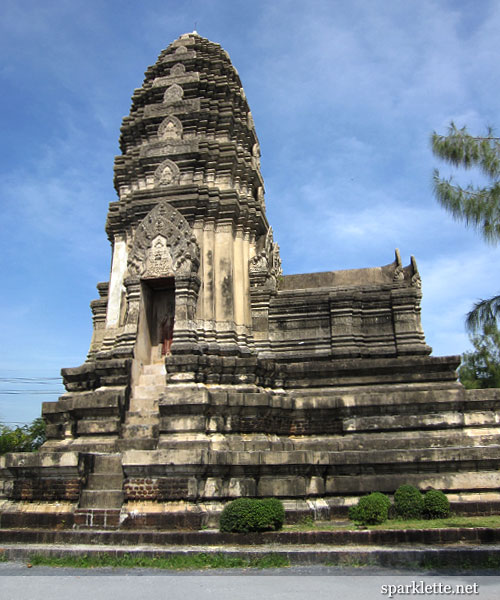
This model of the Stupa of Phra Mahathat in Ratchaburi province is duplicated to scale at three quarters the original size. “Mahathat” sure is a popular name for temples! There seems to be a “Wat Mahathat” in every province!
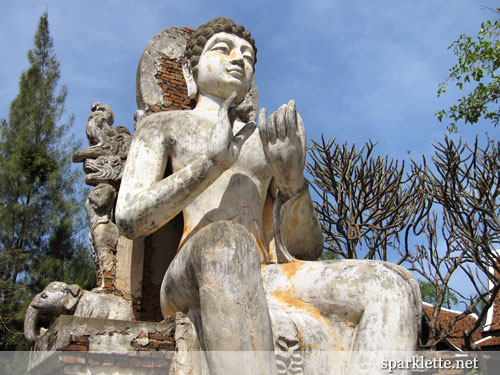
The Buddha’s posture, seated with his feet resting on the floor, so called the teaching posture, is a distinct artistic style of the Dvaravati kingdom that existed from the 6th to 11th centuries.
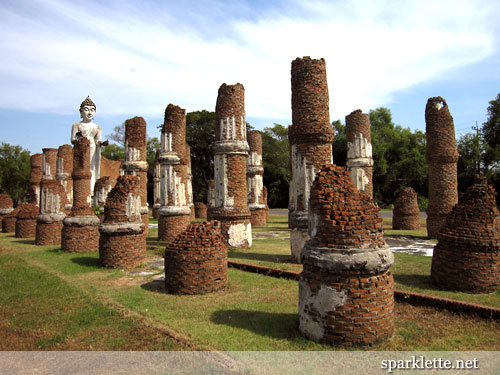
Religious structures and Buddha images constructed during the Dvaravati period tend to be large. With only broken pillars left standing, the wihan (assembly hall) above is not much of a hall anymore. The Muang Boran architects have certainly done a great job in making the monument replicas look as realistic as possible.
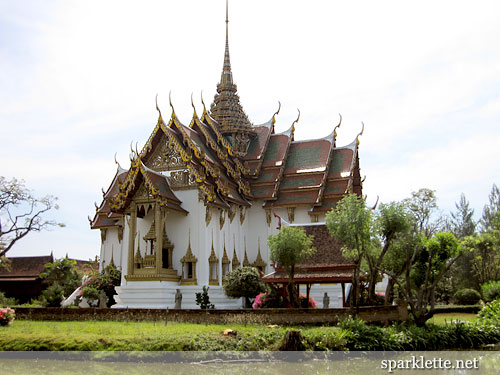
If you have seen the Grand Palace, you should probably recognise this landmark. The Dusit Maha Prasat Palace is the most easily identified structure on the palace grounds. The replica in Muang Boran is meant to recreate the original state of the palace when it was first built in 1806, so it is not exactly identical to the one in the present day, which has seen some modifications over the decades.
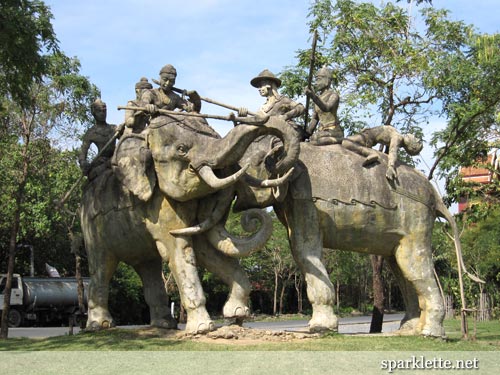
As we’ve already learned from the trip to the Bangkok National Museum, King Naresuan was an outstanding warrior. This monument commemorates the Great Battle of Yuthahathi, in which he defeated the son of the Burmese king in 1592. Kings that can physically fight and win a war simply make my knees go weak.
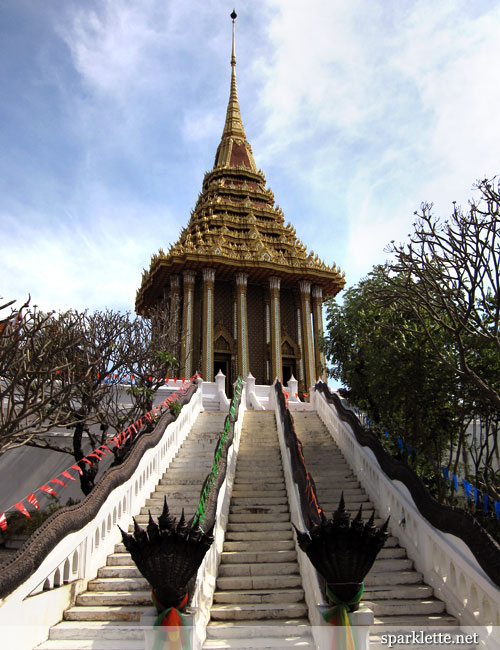
The pair of feet at the foot of the staircase offers a clue as to what this place is. Climb up the steps and you would get closer to the footprint of… Lord Buddha. Considered one of the most sacred places of Thailand, the original structure is on the top of a hill in Saraburi province. As the legend goes…
A hunter named Phran Boon followed a deer that he had shot to the ridge of a low hill. There, he saw the wounded deer drinking water from a small pond. Astonishingly, the wounds on the creature’s body suddenly disappeared. When the deer fled, the hunter came to look at the pond and found that in fact the pond was the footprint of the Buddha. Being reported and investigating the site himself, Phra Chao Song Tham (1620-1628) found the ancient Buddha footprint of which its appearance in Siam was foretold by Ceylonese monks in a Ceylonese scripture.
If you’re wondering whether this replica actually houses any footprint, the answer is yes. It belongs to an Indian president.

Speaking of deer, we spotted some of them grazing in a barricaded area. They were so adorable!
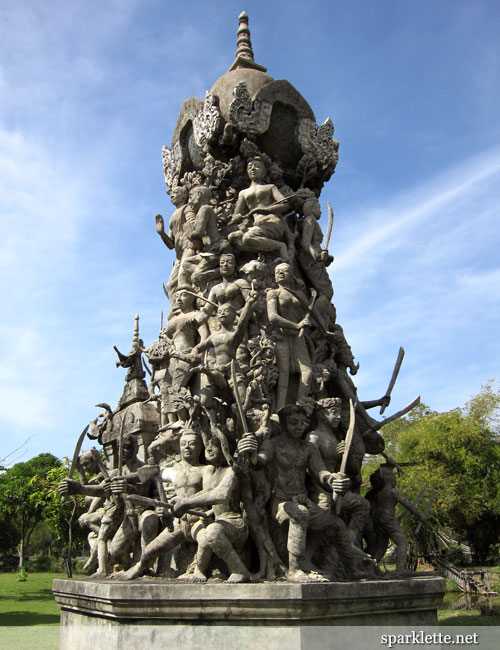
This monument represents the courage of the people of Bang Rachan from the late Ayutthaya period. They were a group of villagers that fought bravely and eventually sacrificed themselves to defend their community from a Burmese siege.
It kind of reminds me of the Heineken Christmas tree.
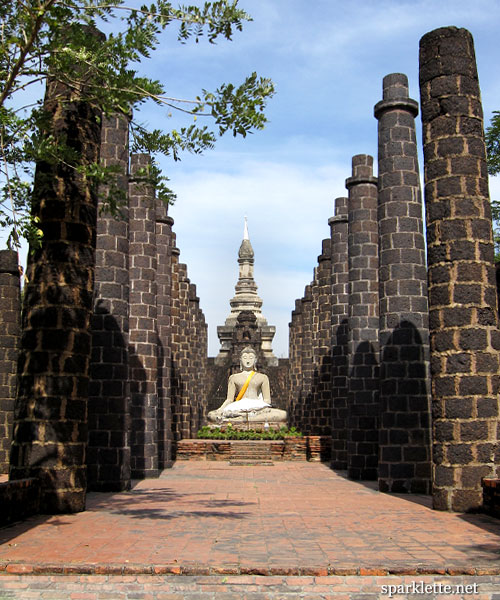
The Grand Hall of Wat Mahathat in sukhothai province now lays in ruins. Imagine what it was like, back in its heyday when the pillars belonged to a whole building. This replica is smaller than the original hall by three quarters.
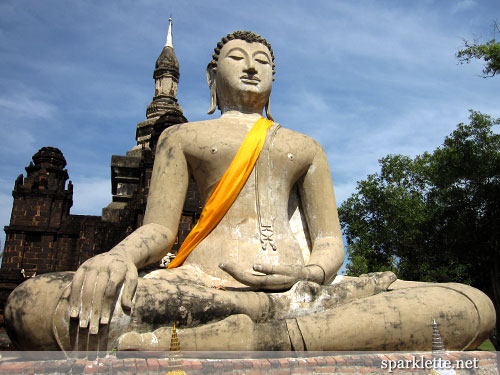
Standing behind the Buddha image is the main chedi (stupa in Thai) of the temple. 2Save.APP
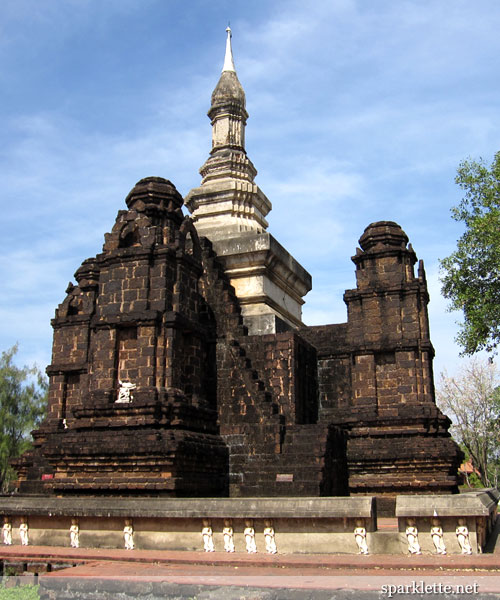
Notice that its square base is accented with little motifs of walking Buddha images.

Along the way, we spotted some big birds by a lake. Those are geese right? Anyway I got off our buggy to get their pictures. When I squatted down, they looked about the same height as me. And then those darn birds came after me! If I wasn’t quick enough I would have been pecked!
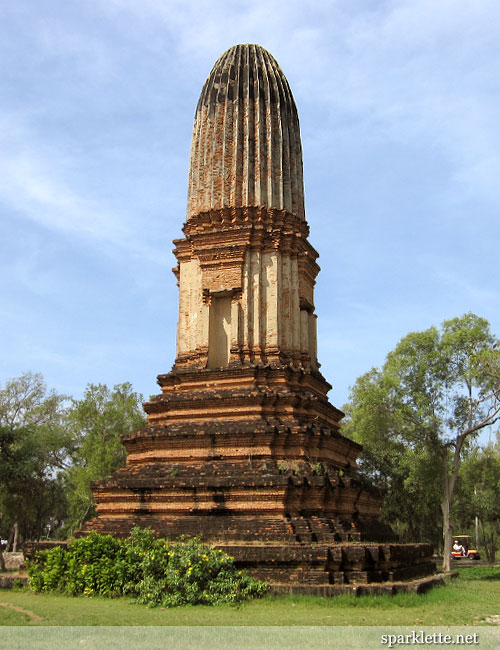
This fruit-shaped tower is modelled after Wat Mahathat, Sankhaburi in Chai Nat (there, another Mahathat!). If you were to ask me what fruit it is, cucumber immediately comes to mind. The actual fruit that gave it its name is actually starfruit (!!!).
The tower goes way back to the pre-Ayutthaya periods, around the 13th century. The unusual thing about this 20 metre tall, 12 metre wide structure is that no plaster was used to hold the bricks together. So how does the whole thing not collapse?
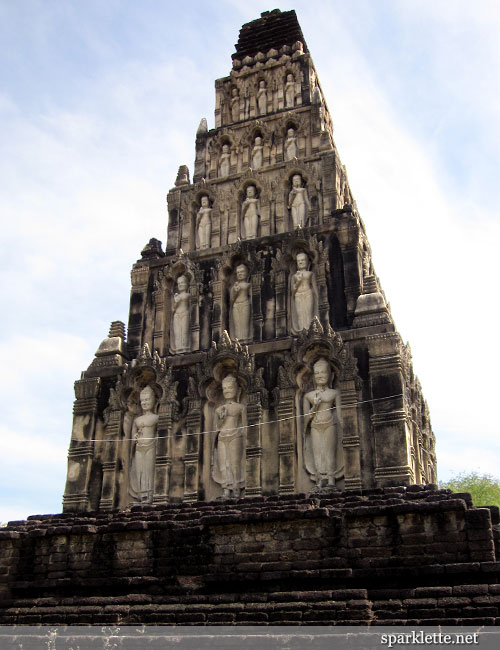
Even older than the fruit-shaped tower is the Chedi of Cham Thewi at Wat Ku Kud, dating back to the 9th and 10th centuries. Quick math question: the stupa bears a pyramidal shape that is divided into 5 levels. On each level there are Buddha images, 3 on each of the 4 sides. How many Buddha images are there altogether?
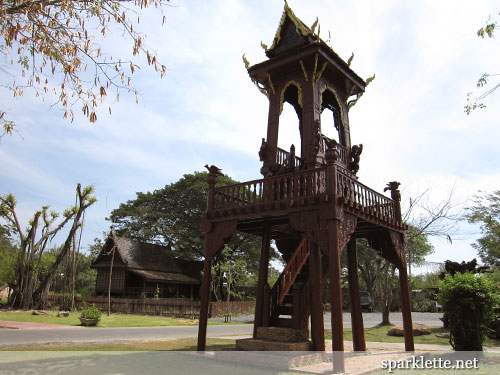
Although most of the monuments here are replicas, some are actually originals that were obtained and refurbished for the park. This bell tower came from Wat Yai, Bang Khonthi in Samut Songkhram province.
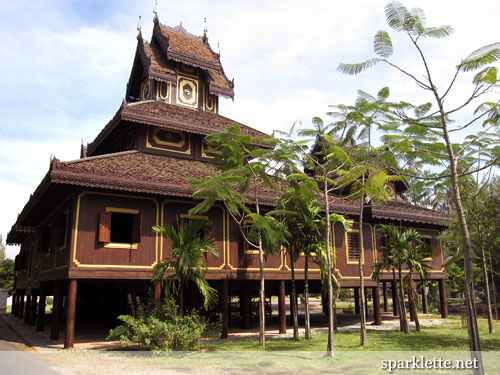
Another original is Wat Chong Kham, a temple-monastery that came from Lampang province. Much care was taken to preserve all the details of the teak building, modelled after pagan architecture.
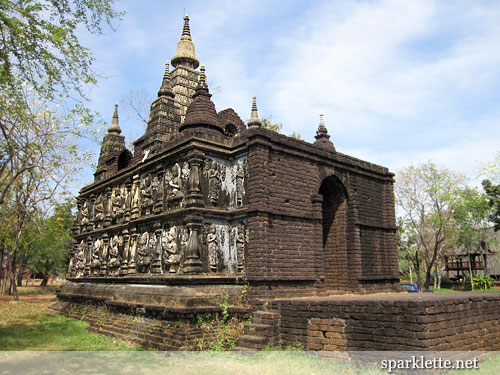
Chedi Chet Yod, the seven-spired pagoda, is currently situated at Wat Photaram Mahawihan in Chiang Mai. The stone arch opening on the main chedi leads to a rectangular hall 10 metres wide and 22 metres deep, with a seated Buddha image. It was built sometime in the 15th century.
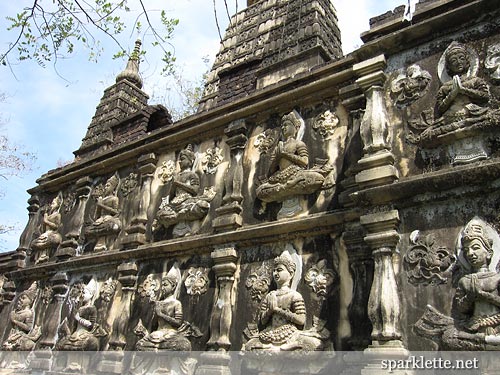
Stucco motifs of Indian celestial beings adorn the base walls.
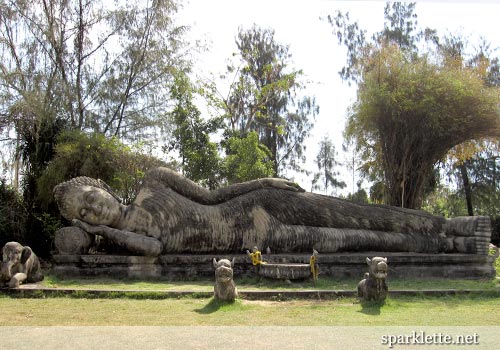
The Reclining Buddha. He has kind of a curvy figure.
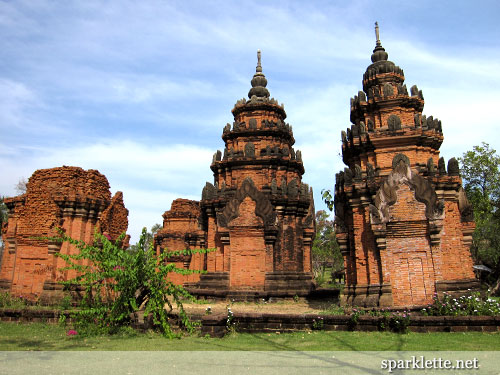
This group of stupas above are replicas of the Sikhoraphum stone sanctuary of Surin province, dating back to the 12th century. They were originally Hinduism stupas, but were eventually converted to Buddhism stupas in the 15th century.
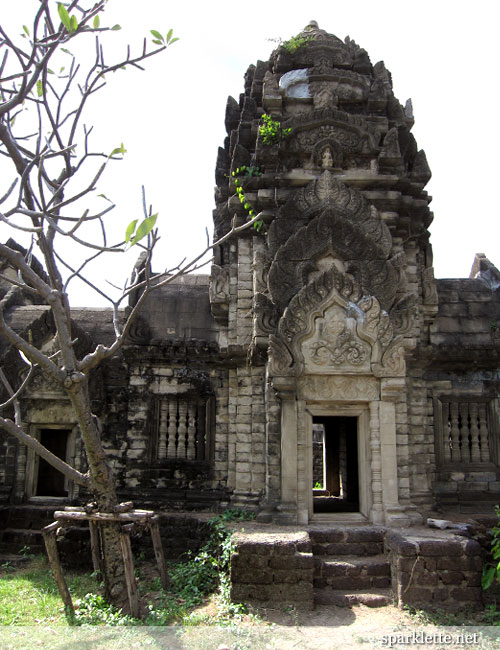
The Phimai stone sanctuary, located in Nakhon Ratchasima province, is the largest Buddhist monument in Thailand.
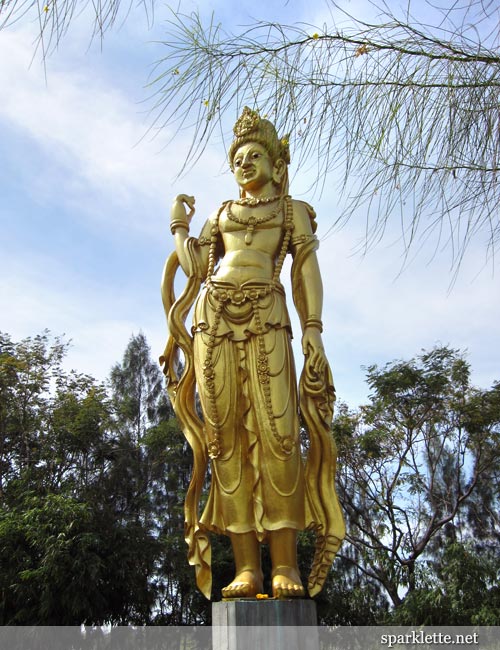
You recognise her, don’t you? Kuan-Yin, the Goddess of Compassion, used to be male until after the Tang dynasty! I didn’t know that!
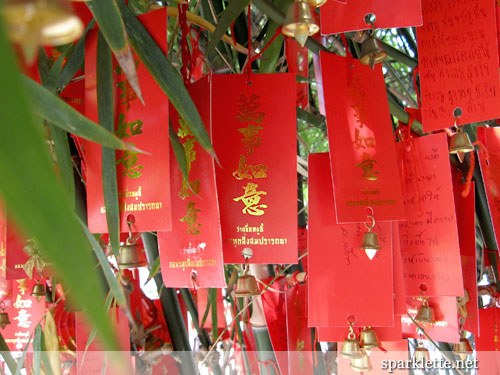
Many locals were spotted praying around kuan-yin. Hanging from the trees around the statue were these red cards with little bells, written with prayers and wishes.
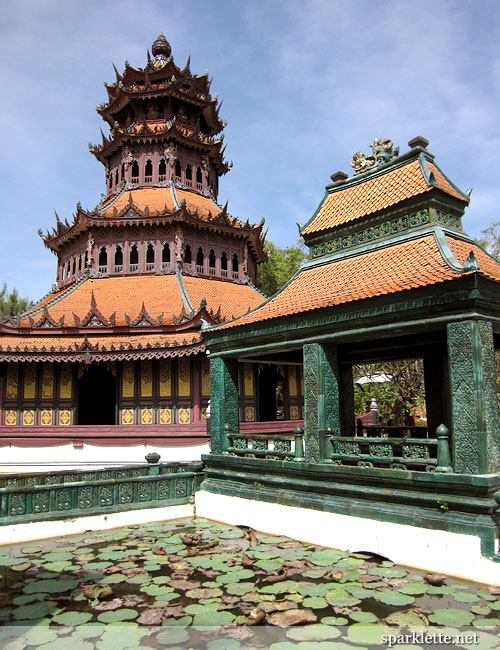
Besides replicas and restored originals, creative designs of the Muang Boran architects can be found here too. Take for instance the Phra Kaew Pavilion above. The octagonal structure was built in the Ayutthayan style to represent Ayutthaya as a centre of Buddhism in the past.
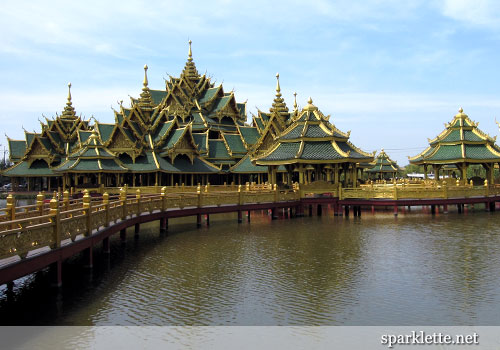
The Pavilion of the Enlightened is very popular with the Thais. As these elaborate pavilions and temples with their green roofs and gold fringes are built upon a lake, they can only be accessed via a bridge.
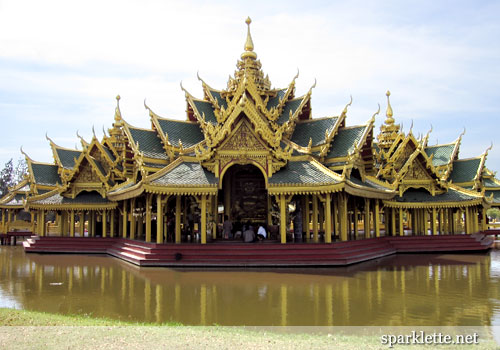
Spot the jolly laughing Buddha!
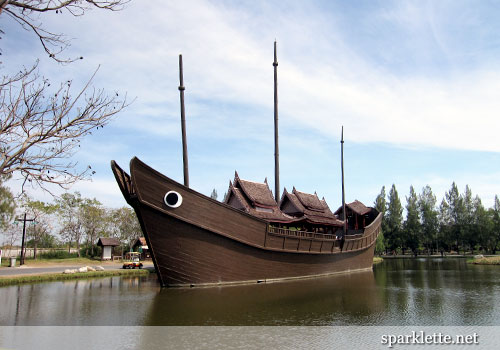
Look, this beautiful ship has eyes! In the past, Bangkok and Ayutthaya benefited from their strategic locations along the Chao Phraya River, the same way Singapore benefited from the Singapore river.
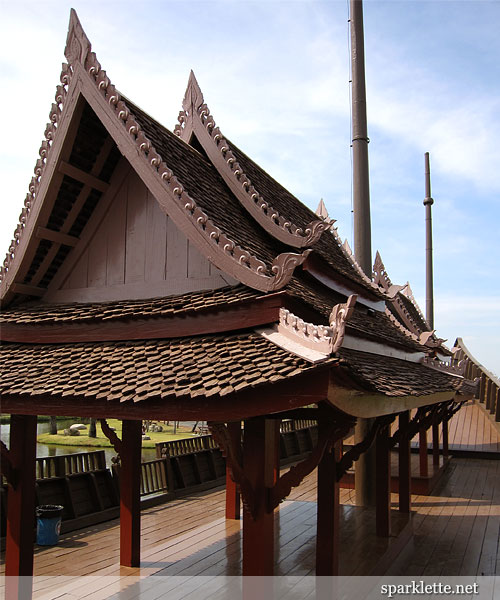
Back then, traders would bring Thai goods overseas using such ships, called Thai junks. They gradually disappeared some 50 years ago.
Altogether there are 116 monuments in Muang Boran so this is just a small sampling of them. Eateries and drinks stalls are littered around the park. There are also a couple of markets selling souvenirs.
It’s hard to believe that this incredible place is really the creation of just one man who had a deep passion for Thai culture and architecture. Today, his heirs continue his legacy. I heard that this magnificent project isn’t even financed by the government. Labor of love indeed! I encourage everyone to go visit it if you can. It would be an experience of a lifetime.
296/1 Sukhumvit Road
Bangpoo
Samut Prakan 10280
Thailand
Tel: +66 0 2709 1644
www.ancientcity.com
Opening hours: 9am – 5pm
Admission: Adults 300 baht; Children 200 baht
Back to Bangkok, we had our lunch/dinner at a nice Japanese restaurant in MBK Center, above the Tokyu department store.
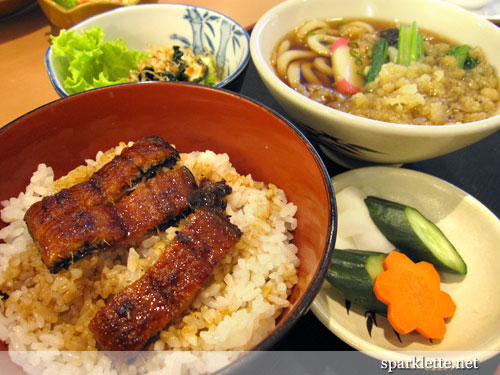
Some of the set meals were extremely value-for-money.
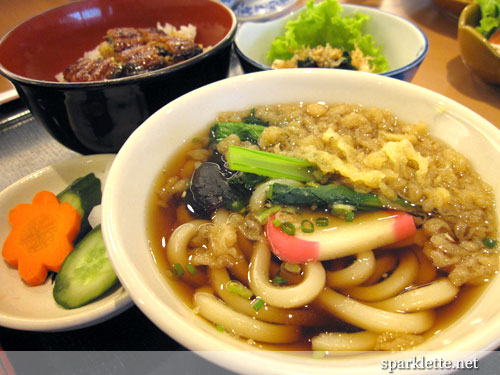
The set meal I had came with the unadon, udon, salad and tofu.
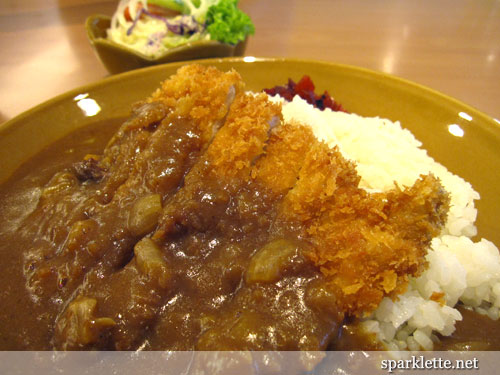
The curry katsu don wasn’t too shabby either. This is one of those places I would return for a meal if I was to visit Bangkok again.
We end the day with drinks at Sirocco, one of the highest bars in the world.
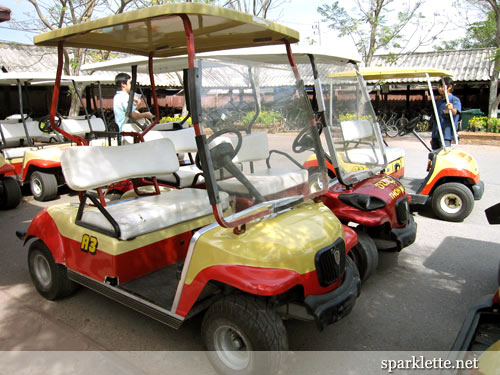
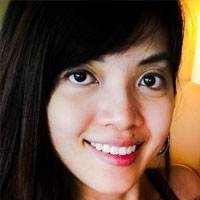
Jan 22, 2009
1
Muang Boran is the most favorite place that I used to visit because I can see every important place in Thailand just in a day.
Jan 25, 2009
3472
Exactly. It’s like taking a shortcut that allows you to get a glimpse of all the sights. That said, nothing beats the sense of achievement when you visit the actual site, knowing that what you’re looking at is the “real” thing.
Jan 22, 2009
6
hi! ur bangkok entries are wonderful!
you make feel some hope for the future, that working life can be fun too if u strive for it :)
Jan 25, 2009
3472
In some sense, working life is fun. It’s different. You become more independent and responsible. Plus, you are able to afford more things, like holidays :) I for one wouldn’t want to go back to my schooling days.
Jan 23, 2009
1
may i know how much did u spend for ur bkk trip. it’s really nice! =)
Jan 25, 2009
3472
Definitely under a grand :)
Jan 24, 2009
14
i sooooooo wanna visit the ancientcity.
Jan 26, 2009
1
What a pretty blog you have. And it’s always nice to see travel images. Never been to Bangkok myself. Those pictures of the ancient city are amazing. I didn’t notice them until I started writing this comment.
Jan 30, 2009
6
hi Veron,
saw u again at lunch today…
HAPPY NIU YEAR!!!… :)
.
Feb 3, 2009
3472
Same to you!
Jan 30, 2009
24
Wonderful picture updates, such spectacular architecture! My friends visited Thailand last summer, I wonder if they were able to go there. I will have to check with them for pictures sake! ahah
MMM…the food looks so good!
Feb 3, 2009
3472
Muang Boran is truly a spectacular piece of work. I doubt many Singaporeans have heard of this place, but they really should!
Jan 31, 2009
182
Happy Chinese New Year Veron.
Nice photos. I was especially attracted to the religious structures. Thanks for sharing.
Feb 3, 2009
3472
Happy Niu year to you too!
Feb 2, 2009
57
Will have to consider going to Muang Boran one day… have to fit that in somewhere along with quite a few places left to visit in Thailand! Thanks for sharing..
Having been myself to Vertigo @ Banyan Tree for dinner, Breeze and Sirocco at the Lebua State Tower (even stayed at the hotel in December), and the Baiyoke SkyTower for dinner, I have to say I enjoyed Vertigo the most.
The Lebua staff not only came off as snooty, but some of their comments from one of the lift waitstaffs (uttered in Thai), were downright rude and completely unacceptable. The hotel rooms are not even that great anyway – they only get away with being a complete washout because of their Bvlgari bathroom amenities. And the food in Breeze is far more reasonably priced (for some items, especially the snowfish, read: cod – it’s divine and well worth it). Anyway, when we went for dinner last time there, the global economy was not yet in recession and the tables were all packed. Also they refused to let anyone take a photo of their precious golden dome…
The Baiyoke Sky Tower was great but the interior is showing its age. Love the roving musician band! Very good for a romantic evening out. Food choice is average, food quality also average, but nice crepe suzettes! Also the cheapest out of the three locations, so that counts for something. They have a nice souvenir cocktail drink ‘bottle’ in the shape of the Sky Tower itself which is adorable and included for you to take home for the price. Tastes okay. Then there’s the rotating viewing platform, which is getting a bit creaky/noisy. Otherwise it’d be great..
Vertigo, however, was not only classy but the food was good, they had someone taking complimentary photographs (which they print out for you as a souvenir – but only one per couple) and the views are also good. No restrictions on photo-taking using your own camera either! Okay – it’s expensive, but you expect that already too.
Hope you get to try out more eclectic places next time you’re there.
In the end, I still enjoy eating simple in MK or MK Gold… great roast duck! Really good value for the price, too..
Feb 4, 2009
3472
Thanks for sharing! I have only great memories of Baiyoke Sky Tower. The manager at the rooftop bar really took good care of me when I was there. The food and drinks were very affordable too considering the unique location. But I agree with you that the interior looks old. At least, it looked old to me back in ’06. That souvenir bottle sounds too cute! I wish I had gotten one! Anyway, the place is certainly worth a second trip.
Vertigo does sound nicer than Sirocco indeed. I don’t know if the staff at Sirocco actually stop customers from taking photos of the dome, but they wouldn’t let me take any pictures outside of the bar area. It was so bizarre.
Feb 3, 2009
1
Wow! The pavillions on the water were featured in a run way show from America’s Next Top Model! Thanks for sharing all of the photos!!
Feb 4, 2009
3472
Wow! That’s brand new information to me! It’s so surprising that an American show would be filmed in a little known place like this. How very resourceful!
Feb 5, 2009
72
Veron, I think you have just done so much more for Thai Tourism than all the newspaper and tv commercials could ever achieve! I should contact the PR manager for the Tourism Authority of Thailand (Khun Kaneungnit) and let her know.. I’m sure she’ll reward you well :P
Feb 6, 2009
3472
Wow you know her by name? Could you be a dear and tell her about these blog posts? I think it would benefit a lot of people visiting Bangkok, even the repeat visitors. I think more people need to know about Muang Boran too!
Feb 6, 2009
72
yep, totally agree with you! I’ve been to Thailand 7 times and don’t even know about Muang Boran – its not really advertised in those tourist brochures or websites. I’ve always wanted to visit Ayutthaya but always procrastinated or ran out of time. Your earlier blog post really brought the ancient city to life, and I love the travel tips you provide – it really helps!
Yeh, I’ll gladly drop an email to Khun Kaneungnit – I was liaising with her for my previous job. But she’s one hellava busy lady, haha
Feb 10, 2009
3472
Thanks so much dude! Much appreciated :)
Oh yeah you should totally visit Ayutthaya. It’s a whole lot different from Bangkok. The pace is slower, more peaceful, and no one tries to rip you off (I think). Muang Boran has mini versions of some of the famous landmarks there, but nothing beats the real thing. Speaking of which, I think Muang Boran is not advertised in tourist brochures because it’s a private project by a few individuals and not supported by the government.
Feb 9, 2009
1
I have spent some time in Bangkok, off and on for some 2yrs on a great project, unfortunately since aborted. I have very, very fond memories of Bangkok, and Thailand. Your website brings it all back to me. I have fond memories of an afternoon tea at the Vertigo, but regretfully have never heard of Muang Boran until now. Anyway, I wouldn’t have had time to visit then, even had I known…. This is added incentive for me to return to Krungthep!
Great site, thanks for the memories!
Feb 20, 2009
2
Hi Veron,
Wow your blog about Bangkok is awesome, excellent pixs too. I need some help. My trip is 4/3 nights – 7-10 March. Since I dont have many days, definitely will go to Muang Boran to cover all the Bangkok historical sites. Can you tell me how long to cover the whole area, 1/2 day is sufficient? Then I head off to Grand Palace and Wat Arun and Reclining Buddha.
Appreciate your advises.
sooshing
Feb 20, 2009
3472
Hey Soo Shing,
So happy to read that you’re going to Muang Boran! Half a day would be sufficient. We covered most of the sites within 3 hours in our golf cart!
Feb 21, 2009
72
Thanks Veron for the tip. I was about to ask the same question as Soo Shing since i’ll be in Bkk on the Good Friday long weekend. Will definitely visit Muang Boran.
U keen to travel to Bkk again?
Feb 21, 2009
3472
I don’t think I would be going there again anytime soon. But you sure are a frequent BKK visitor! How many times do you travel there in a year?
Feb 21, 2009
72
haha.. i travel to Thailand around 4-5 times a year, got lots of friends living and working there. Hence that’s why I miss out on doing the touristy stuff since I mostly go shopping, eating & clubbing with my friends. Anyway, u got my email so give me a buzz if you’re heading to the land of smiles again :)
Mar 29, 2009
5
Hi veron,
do you remeber how much is the cab fare from muang boran to city? 1 hour each so total 2 hr right? or u book the cab for the day? i m writing my own itinery for bgk~ going there soon next mth~ your help is much appreciated!!
Regard
minty_sky
Apr 11, 2009
72
Veron, i’m writing this now in Bkk – went to Muang Boran today and its good to actually see the photo snaps i took versus your descriptions. Unfortunately I arrived there quite late, around 5pm and the motorised golf buggies weren’t available – had to use my peddle-power and ride around the massive place on those old-rusty bicycles *yuck*
spent 2 hrs there but its definitely NOT enough time, at least 3 hrs is a must if you wanna visit every place and read about the history behind it.
(oh yeah, I saw those homicidal geese but i didn’t wanna go near them based on reading your blog, haha)
anyway, the place was all decked out in celebratory flags etc. due to the upcoming Songkran festival.
Apr 11, 2009
3472
Hey, you got a taste of Muang Boran! Excellent! Yup, I would recommend spending half a day there if you want to explore the place without having to hurry about. The description and history of each place can also be found on the website (a very meticulously-developed one, I must say) linked above. So don’t feel too bad now :)
Oh I think most of the visitors there moved around on bicycles. Only 3 or 4 buggies, including ours, were sighted.
Ack, those geese were fierce! O how they terrified me so. I don’t think I can ever forget! lol!
Apr 29, 2009
1
Hi Veron,
Would you advice on the drink chargers at Sirocco the Rooftop Bar?
Apr 29, 2009
3472
I think it was about US$15 for a shot. A small beer cost around the same. Not cheap!
May 20, 2009
1
I’m visiting Ancient City this coming Sunday with a Thai friend who’s never been there. I’ve been there three times before, but it’s always fun to see it through a new person’s eyes—especially Thai!
Your blog was so informative that I printed it off to take with me. Much better than the brochure they hand out at the park! Thanks.
May 23, 2009
3472
Wow! I sure didn’t expect anyone to find this blog post so useful! Thanks for showing so much appreciation. And I think your Thai friend would be able to tell you a lot more too! Enjoy your adventure :)
Aug 4, 2009
3
hi veron, i was at the last minute of doing my itinerary when i saw muang boran. can you let me know, if this is near the airport, coz i wanted to go here first before going to my hotel, since you mentioned already that its a good place to see… if its near airport then i will probably go here instead as my first stop….coz im flying fr sg to bkk around 715am….i want to spend the first few hours worthwhile before check in at my hotel.
Jul 1, 2010
1
il est vrai que muang boran est est un endroit a visité absolument en thailand ,pour la diversité de ses oeuvres qui montre bien la richesse de la culture thaï.
j ai eu la chance de faire le tournage du film ,deux freres de jean jacque anno durant trois semaine a l interieur du parc muang boran.
bref je vous recommande la visite de ce site incroyable autant pour sont architecture que ca beauté….
bon voyage a tous.
May 4, 2011
2
May I ask you, how many time muang boran from bangkok or how many km’s from bangkok
May 4, 2011
3472
I googled this. From Thailand.com:
“Muang Boran is located on the old Sukhumvit Highway, about 33 km east of central Bangkok.”
Jul 3, 2011
1
any idea how much does the renting of golf cart cost? as i m going to bkk in a week time.. would actuali visit this place that u recommend. would appreciate if u can reply mi soon.. :)
how about the cab fare?